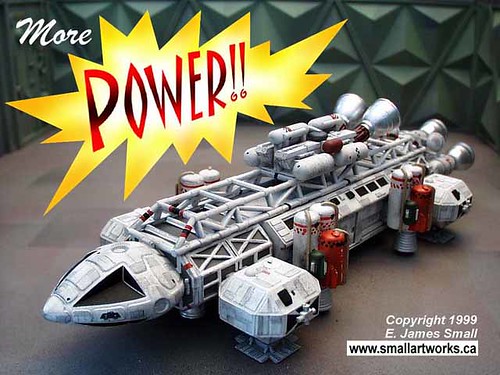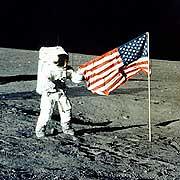
Nasa says they're gonna get to the moon with spare parts...
Heck, that's good enough for me. Here's the scoop from mega-cool periodical USAToday:
NASA to unveil plans for 2018 moon mission
By Brian Berger, Space.com
WASHINGTON — NASA briefed senior White House officials Wednesday on its plan to spend $100 billion and the next 12 years building the spacecraft and rockets it needs to put humans back on the moon by 2018.
(Apollo 12 mission Commander Charles P. "Pete" Conrad is shown on the moon's surface in this Nov. 1969 file photo. NASA file via AP)
 .... ok, this photo is just so fake. They should have gone with a super awesome ulta mega cool picture, like the one I found above..... yeah! We're gonna fuck up that Moon with Red, White and Blue POWER!
.... ok, this photo is just so fake. They should have gone with a super awesome ulta mega cool picture, like the one I found above..... yeah! We're gonna fuck up that Moon with Red, White and Blue POWER!"America! FUCK YEAH! Coming again, to save the mother fucking day yeah"
The U.S. space agency now expects to roll out its lunar exploration plan to key Congressional committees on Friday and to the broader public through a news conference on Monday, Washington sources tell Space.com.
President George W. Bush called in January 2004 for the United States to return to the moon by 2020 as the first major step in a broader space exploration vision aimed at extending the human presence throughout the solar system.
NASA has been working intensely since April on an exploration plan that entails building an 18-foot (5.5-meter) blunt body crew capsule and launchers built from major space shuttle components, including the main engines, solid rocket boosters and massive external fuel tanks.
That plan, called the Exploration Systems Architecture Study, was presented by NASA Administrator Mike Griffin, his space operations chief Bill Gerstenmaier and several other senior agency officials Wednesday afternoon to senior White House policy officials, including an advisor to Vice President Dick Cheney and the president's Deputy National Security Advisor J.D. Crouch.
NASA's plan, according to briefing charts obtained by Space.com, envisions beginning a sustained lunar exploration campaign in 2018 by landing four astronauts on the moon for a seven-day stay.
The expedition would begin, these charts show, by launching the lunar lander and Earth departure stage (essentially a giant propulsion module) on a heavy-lift launch vehicle that would be lifted into orbit by five space shuttle main engines and a pair of five-segment shuttle solid rocket boosters.
Once the Earth departure stage and lunar lander are safely in orbit, NASA would launch the Crew Exploration Vehicle capsule atop a new launcher built from a four-segment shuttle solid rocket booster and an upper stage powered by a single space shuttle main engine.
The CEV would then dock with the lunar lander and Earth departure stage and begin its several day journey to the moon.
NASA's plan envisions being able to land four-person human crews anywhere on the moon's surface and to eventually use the system to transport crew members to and from a lunar outpost that it would consider building on the lunar south pole, according to the charts, because of the regions elevated quantities of hydrogen and possibly water ice.
One of NASA's reasons for going back to the moon is to demonstrate that astronauts can essentially "live off the land" by using lunar resources to produce potable water, fuel and other valuable commodities. Such capabilities are considered extremely important to human expeditions to Mars which, because of the distances involved, would be much longer missions entailing a minimum of 500 days spent on the planet's surface.
NASA's Crew Exploration Vehicle is expected to cost $5.5 billion to develop, according to government and industry sources, and the Crew Launch Vehicle another $4.5 billion. The heavy-lift launcher, which would be capable of lofting 125 metric tons of payload, is expected to cost more than $5 billion but less than $10 billion to develop, according to these sources.
NASA's plan also calls for using the Crew Exploration Vehicle, equipped with as many as six seats, to transport astronauts to and from the international space station. An unmanned version of the Crew Exploration Vehicle could be used to deliver a limited amount of cargo to the space station.
NASA would like to field the Crew Exploration Vehicle by 2011, or within a year of when it plans to fly the space shuttle for the last time. Development of the heavy lift launcher, lunar lander and Earth departure stage would begin in 2011. By that time, according to NASA's charts, the space agency would expect to be spending $7 billion a year on its exploration efforts, a figure projected to grow to more than $15 billion a year by 2018, that date NASA has targeted for its first human lunar landing since Apollo 17 in 1972.
Senate approves $16.4 billion budget
The U.S. Senate approved a $200 million budget increase for NASA Thursday.
The NASA funding was approved as part of a $48.9 billion spending bill that also funds the Justice and Commerce Departments. Of that amount, NASA would receive $16.4 billion for 2006, about $60 million less than the agency requested but $200 million more than it had to spend this year.
The House of Representatives approved NASA's budget in July, providing $15 million more for NASA than it requested but the House bill also would require NASA to spend $110 million more on aeronautics research than it would like, or $952 million.
Similarly, the Senate bill would require NASA to spend $250 million in the year ahead preparing for a space shuttle mission to refurbish the Hubble Space Telescope. NASA requested only a fraction of that amount for the proposed mission.
Sen. Barbara Mikulski (D-Md.), a senior member of the Senate Appropriations Committee, issued a press release Thursday afternoon highlighting, among other things, the extra money added funds for the Hubble Space Telescope. Her press release also states that the $16.4 billion approved by the Senate "fully funds all major space science and earth science programs, the space shuttle, space station, the Crew Exploration Vehicle (CEV) and the Moon-Mars initiative."
The Senate passed the spending bill by a vote of 91-4.
The House and Senate now must work out the differences between the two bills before sending the spending legislation to the White House for the president to sign into law.
3 comments:
Planning our first trip to the moon eh? Better late than never i guess.
Well, I suppose it would be our second eh?
Second in 35 years... erg.
That was a joke. I thought is was funny anyway. Last time i try to do that. I wonder if the Chinese will beat us there?
Post a Comment